
Official Edgar Rice Burroughs Tribute and Weekly Webzine Site
Since 1996 ~ Over 15,000 Webpages in Archive
Volume 0450

|
Before Tarzan of the Apes
there was
|
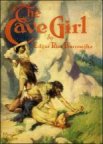


The Lad and the Lion (1917) was the first film made of a Burroughs story and the Selig Polyscope Company paid ERB $100 per reel for this five-reeler. Despite his considerable efforts to get film companies interested in his stories, this was the only success he had until Tarzan of the Apes was filmed the next year. The Lad and the Lion had the distinction of having its premiere (May 14, 1917) coincide with the print release of the story in All-Story Weekly. The film story was loosely remade in 1937 under the title The Lion Man.
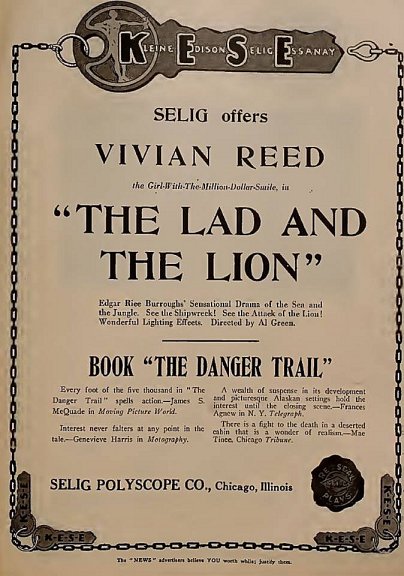
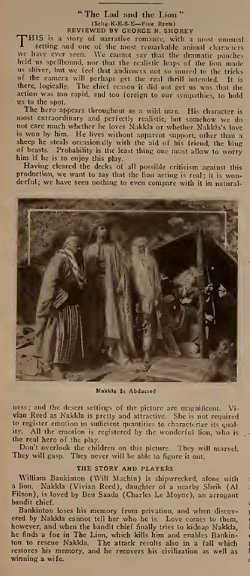

MOVING PICTURE WORLD ~ May 26, 1917 Review
James Bankington, a millionaire, consents to his only son, William, making a trip to Africa. The boy takes passage with Captain Tagst. They pass a sailing vessel carrying a caged lion to America. In the hold there is a stowaway named Broot, and the pipe he smokes starts a fire. Knowing there is a consignment of gunpowder, the captain and crew abandon ship. The stowaway extinguishes the blaze and discovers the lion.Captain Tagst's ship is wrecked and William is left alone on the raft. The stowaway rescues the lad. Fright and exposure have robbed him of his memory. Time passes, and the lad has made friends with the lion, for both are kicked and cuffed by Broot, the stowaway. Later, the lion escapes and Broot leaps overboard.
In the after years, the lad and the lion continue as comrades in their lair near the desert. Nearby lies a little Arab village where Sheik Ali-Es-Hadji rules with his daughter Nakhla, who is a self-willed, self assertive, high spirited beauty.
Ben Saada, the arrogant chief of a band of brigands, asks for Nakhla to be his wife. "Give me time to think, my father. I am not yet sure that I love Ben Saada," exclaims Nakhla. Trembling with rage, the brigand bows in obedience to the girl's decision.
The lad and the lion discover an antelope. Saada, returning home from his mission, also sees the antelope and kills it. His men, seeing a monstrous lion with a man standing beside it, flee and the lad claims the antelope. Returning to the village, Saada tells the Sheik that he has seen a white devil with a lion as his companion. The Sheik and Nakhla laugh, rousing the man to fury.
Nakhla rides into the hills one morning and comes to a waterfall. The lad and the lion are nearby, and Nakhla's horse, scenting the lion, runs away. The girl sees the man and the beast and also endeavours to escape. Four brigands see the girl and attack her. The lad sends the lion to her rescue. The brigands flee, leaving one of their band slain. The lion approaches the cowering girl and the lad assures her that she will not be harmed.
The man and the maid are mutually attracted to each other. At the suggestion of Nakhla, the lad puts on the garments of the slain Arab. When Nakhla's horse returns to the village, the Sheik is about to send a party to search for his daughter, when the girl returns and tells him of her experience.
Nakhla and the lad meet frequently. The princess soon learns to love the handsome stranger, and the lad thinks that never before has he seen anyone so beautiful. Saada informs the Sheik that "the white dog is following in the footsteps of the beauteous one." Then, the Sheik forbids his daughter to go again into the desert.
Saada tells the lad that the girl has married one of her own tribe. The grief stricken lad again dons his animal skins. Marie, daughter of Colonel Vivier, commander of the French garrison, is spending the day in the hills when the lion encounters them. The Arab servants leave the girl to her fate. The lad appears, calms her fears, and escorts her home. Col. Vivier, grateful to the lad, makes him a dragoman.
The Colonel visits the Arab village and the lad accompanies him. In the village he again sees Nakhla and his love for her intensifies. Nakhla, seeing the lad with Marie, believes that he has forsaken her.
Finally, Saada decides to abduct Nakhla and force her into marriage. The plot partially succeeds. He takes the girl to his camp, sending one of his servants with an ultimatum to the Sheik. The Sheik summons the soldiers and vows he will rescue his daughter. The lad, with his lion, also institutes a search and meets Ben Saada.
The bandit strikes the lad a fierce blow on the head. The lion, seeing his beloved master attacked, springs upon Saada and kills him. The blow revives the lad's memory. He realizes that he is William Bankington, son of the millionaire. He does not forget his love for Nakhla, however, and he takes the beautiful girl in his arms.
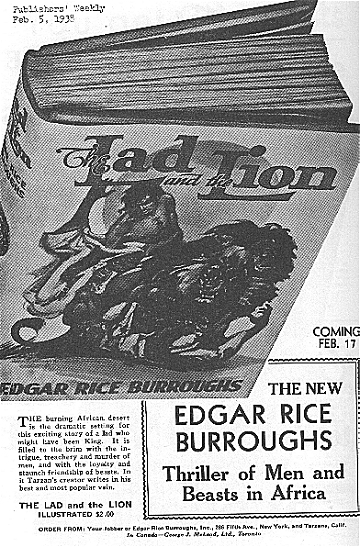 |
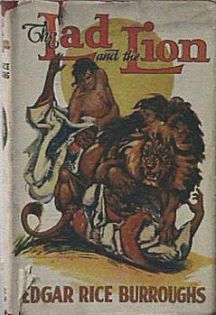
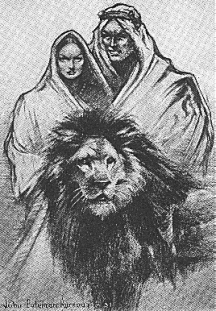 |
THE LION MAN The 1936 film ~ The Lion Man ~ was a remake of ~ The Lad and the Lion. Presented below is the 4-page press book that was distributed to movie theatres in advance of the film's release. This film departed so far from the original ERB story that it has very little in common with the novel or the 1917 film.
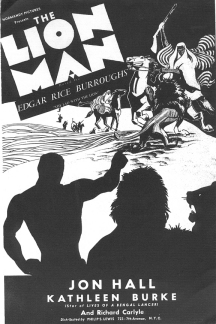
Click to see full screen image |
Presents THE LION MAN Based on EDGAR RICE BURROUGHS' "The Lad and the Lion" John Hall
|
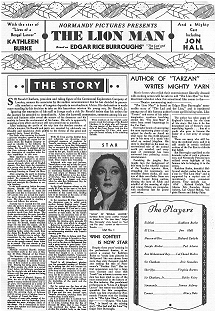
Click to see full screen image |
Lion Man, The (1936)IMDB Internet Movie Data Base Plot Summary: A British financier is among those murdered by a treacherous shiek. The man's son, who survived the massacre, is raised in the desert and becomes known as "El Lion." When he becomes an adult, he begins to search for the man who murdered his father. |
AUTHOR OF "TARZAN" WRITES MIGHTY YARN Movie lovers who relish their entertainment liberally dressed with exciting action will be safe to add "The Lion Man" to their theatrical calendar when this sensational film comes to the ------------- Theatre commencing next ---------------."The Lion Man" is based on Edgar Rice Burroughs' memorable story of "The Lad and the Lion," and is numbered among one of this famous author's most spell-binding tales. Like "Tarzan" and scores of his other imaginative creations involving animal life, "The Lion Man" is taken from actual happenings in the Far East.
Burroughs' knack of uncovering the most captivating phase of any subject he dwells on found an ideal topic for this thrill-dripped pen in his story of a youth who ruled an animal kingdom. His story is described as the most unconventional tale of the animal world yet revealed, and every page of excitement has been converted into pulsating screen entertainment.
Forsaking the jungles, Burroughs lays the background of this story in the colorful expanse of the Arabian interior. Here, struggling for supremacy, are countless desert sheiks, all masters of their own flocks. Some are virtuous, honest living natives, obeying the laws of Allah and mindful of the meaning of right and wrong. Others are renegades with murderous lust for power and riches.
The author has taken pages of England's history for the facts of his story. But into it he has dramatized one of history's most mystifying legends... that of a youth who grew to become the leader of a vast army of savage lions.
There are many who still believe the mythical story, and it is still unsafe in certain civilized sections of the Far East to ridicule that belief.
But Burroughs capitalized on the dramatic value of such a phenomenon, and Normandy Pictures have utilized every highlight of his famous tale in bringing it to the screen.
Kathleen Burke, beautiful Hollywood starlet, makes her bow as a star in "The Lion Man" and is supported by a capital cast of movietown's most competent players. They include Jon Hall, Richard Carlyle, Ted Adams, Eric Snowden, Jimmy Aubrey, Lal Chand Mehra, Virginia Barton and Bobby Fairy.
THE STORY Sir Ronald Chatham, president and ruling figure of the Continental Exploration Company of London, amazes his associates by the sudden announcement that he has decided to personally conduct a survey of tungsten deposits in semi-barbaric Africa. His declaration is made more starling by his decision to take on this hazardous mission his young son, Sir Ronald, Jr.Ignoring the entreaties of his staff to forego such a risk Sir Ronald insists that his orders for the journey be attended to immediately. After the farewell ceremonies, comment among his servants and business aides reveal the sorrow of his demeanor and his anxiety to leave the environment of his home. His wife is apparently enjoying a love affair and honor will not permit him to interfere.
After enduring the perils of the trip into the desolate reaches of Africa's interior, Sir Ronald and party are escorted by obviously unfriendly and suspicious Arab guides to the throne of the great and powerful Sheik, Yussef Ab Dhur.
The Sheik, after tendering Sir Ronald a gracious reception, agrees to his proposition to explore the region for deposits which his English company regard as valuable to the industry. In exchange for a liberal fee for such rights, Sir Ronald is pledged protection from unknown bands blamed for the destruction of countless other foreign expeditions in this area.
Most significant during the transaction, which is cloaked in an atmosphere of treachery, is the presence of a woman obviously white and of English descent. Her face bears the expression of a sorrow that is old as she stares at Sir Ronald and the small boy who are trustingly listening to Yussef Ab Dhur.
After assigning the party to sleeping quarters, the trickery of Yusself is revealed. He commands his servants to invite other foreign competitors into the field and consigns Sir Chatham to certain butchery.
IN the early morning, before the party departs, Sheriffa the white woman makes a bold attempt to reach Sir Ronald's tent but is frustrated by Yussef's guides who are to lead the exploring party through the bandit-infested pass. She does succeed in stealing a horse and follows the caravan.
Scarcely has it reached the first pass when the party is thrown into wild confusion. Rifle shots whine and spatter against the rocks and only the English members topple from their horses. The Arabs, accompanying the party brandish their rifles as a gesture of rushing the invaders but immediately retreat into the thickets. One by one the Englishmen fall. Sir Ronald, fatally wounded drags his son from his mount. As he strives to refill his pistol, Sheriffa, riding past the mad, shrieking circle of attacking Arabs, seizes the youth form the dying Sir Ronald's arms and continues her frenzied race to safety. Her recognition by the raiders as Yussef's woman saves from quick capture, but as she speeds onward, three riders go in pursuit. The rest remain to loot the possessions of the massacred Englishmen.
Mortally wounded Sheriffa delivers the terrified youth to the arms of Hassam El Dhin, Messiah of the Desert.
The Messiah's cult is unmolested by all wrong-doers of the desert because his small kingdom is defended by an army of lions trained to obey his every wish. Hearing her dying story, Hassam El Dhin anoints the child in a scared ritual before his followers, proclaiming him the disciple who will bring them an alliance with the great powers and bring peace to all Asia.
In the steps of Messiah Hassam El Dhin, the son of Sir Ronald Chatham, grows to young manhood known only as El L'ion. His reputation as a savior of English parties seeking to explore the dangerous zones has become the admiration of the father country. By the same token, his growing flock of believers and his savage army of fighting lions is the despair of Yussef Ab Dhur.
Reports of every safe passage of foreign explorers into his forbidden lands infuriate the once Almighty Sheik of the Desert. He is determined to exterminate this ruthless and daring protégé of the Messiah.
While El L'ion and his faithful lions and adherents are thwarting every attempted massacre of explorers by Yussef's murderers, the Sheik is using every scheme to force Ben Mohammed Bey to command his daughter Eulelah to become his wife. Spurned and insulted by the girl, Yussef sends a band of his warriors to capture her, El L'ion, training his lions near the scene, annihilates the raiders and rescues Eulelah. Thus begins their friendship.
Infuriated with rage and jealousy, Yussef plots a new way to halt the growing popularity of this youth and his expanding kingdom. He is successful in convincing Eulelah's father of the low caste origin of Hassam El Dhin, whom all still to be the father of El L'ion. Thus El L'ion hears himself branded as a beggar and scum when he asks Ben Mohammed Bey for consent to wed Eulelah.
In the final desperate scheme to discredit El L'ion in the eyes of his flock and Eulelah, Yussef sends a fraudulent invitation to his hated rival, bidding him to be honored at the camp of the Great Sheik Ali-Es-Hadgi.
In the meantime El L'ion departs to the dangerous pass to safely guide another famous English party. Yussef plans an attack but changes his mind when he observes El L'ion and a beautiful girl in the group are particularly attentive to each other. At the festive ceremony in the luxurious tent of Ali-Es-Hadgi, Yussef's trickery is successful, for beside exciting the jealousy of Eulelah, his dancing girls persuade El L'ion to drink wine which is drugged.
Before he is rescued by some of his faithful flock, El L'ion, who is under the influence of the drugs, is tricked into an embarrassing situation with Yussef's dancing girls.
Hassam El Dhin is furious with Yusseff when his protege is brought to him, half in a stupor. He quickly revives the boy, and as he does so Mohammed Bey and a party arrive in great haste. Contritely he begs the Messiah's forgiveness, for he has since learned that the honorary reception was a fraud and that Yussef had staged it as a means to seize his daughter, Eulelah.Commanding his followers to surround the area, El L'ion musters his army of lions.
Yussef is all triumphant, gloating over his successful capture of Eulelah. He is telling hier she will become his wife whether she consents to or not. Rifle shots and the confusion of conflict from a distance gives him more assurance, for he is certain now, in the fortitude of his retreat, his men are too much for El L'ion's adherents without the leadership of the youth and the host of beasts.
But he cannot see the fury of the battle nor the frenzy of his marauders on the outside. In one bolting rush El L'ion and his men descend upon Yussef's defenders, crushing them and sending them in wild terror.
So it is Yussef who is suddenly horrified to find himself in the iron clutches of El L'ion, hearing form the lips of Hassam El Dhin, that it was Yussef who murdered his father, the boy pitches his crushed body to the lions.
When members of the English party present reveal the heritage of Sir Ronald Chatham, it is plain who will become the new master of the desert and disciple of the Great Power. And the first to congratulate El L'ion, with more than the formal salaam, is the admiring Eulelah.
SHOWMANSHIP 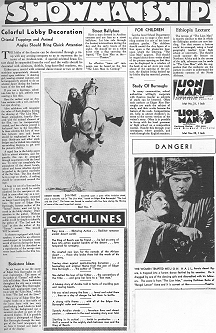
Click to see full screen version
CATCHLINESFiery Love... Blistering Action... Red-hot romance amidst desert sands!
The King of Beasts was his friend... he led an army of lions into action against bandits of the desert... love tempered his savagery.
He created new laws for the nomads of the African desert... those who broke them felt the wrath of his lion army.
Tearing claws against quick-shooting horsemen... a fascinating and original theme from the pen of Edgar Rice Burroughs... the author of "Tarzan."
She defied the laws of her father... the conventions of the tribe... and gave her love to a "lion man."
A blazing story of Arabia told in terms of crackling guns and roaring beasts.
He was raised among the lions... loved an ruled them... then on a day of danger he led them into battle.
A strong virile theme... with all of the Edgar Rice Burroughs' color and movement.
Speedy Arabian steeds... ferocious lions and desert passion... elements in the most amazing story ever told.
Startling in its action!... lavish in production... a thrill a second in the mighty clash between man and the king of beasts
COLORFUL LOBBY DECORATION
Oriental Trappings and Animal Angles Should Bring Quick AttentionThe lobby of the theatre can be decorated through a tie-up with any awning company so as to represent the interior of an Arabian tent. A special oriental brass fixture should be suspended from t he roof and the walls would be decorated with scimitars, shields, long-barrelled muskets, etc.
Either use a record with oriental dance music or two or three musicians appropriately dressed, seated upon cushions. A dancing girl, wearing oriental costume, can be inexpensively secured to do an oriental dance during the busiest hours of the day and night.
If you use a doorman, substitute him for a tall, athletic man wearing a lion skin.
Have the cashier wear an Arabian costume with a veil, and only her eyes showing.
Alive exhibitors will recognize the value of their displays during the showing of "The Lion Man." Desert atmosphere, heavily flavored with the animal element of the film, can be inexpensively created, and has always proved a fool-proof lure to the box-office. In these exhibits the fury of warfare between men and beasts should be emphasized to the utmost. Stock-cuts and other stock designs can be tricked into making eye-catching displays to get over the picture's thrills.
A caged lion in the lobby never fails to attract attention, and frequently, this can be arranged through cooperation with the local zoo. To carry out completely the atmosphere of the desert locale, ushers and house attaches should be garbed in the native wardrobe of the Far East. The lion should be in a cage on wheels. A railing should be constructed around the cage.
A huge cut out of a lion and the figure of a man could be easily contrived for the marquee or utilized in some other way as a novelty title. Lithographs mounted on beaver board simplify this feature. The name Edgar Rice Burroughs, famous author of the "Tarzan" Series, must not be ignored in the lobby display. Draw attention to the author. Without any pretense at deception to the public, it will be simple to identify the author of "The Lad and the Lion" as also the author of the "Tarzan" stories. This should NOT be missed.
In theatres equipped with loudspeakers, it would be an effective crowd-stopper to broadcast some record of horrors during the heavy traffic. It should be described as a reproduction of the savage man versus beast battle in the film feature.
BOOKSTORE IDEAS Do not forget to use the name of Edgar Rice Burroughs on all your exploitation. The name of the author of "Tarzan" will definitely sell tickets. Have bookstores throughout the city use a window display of Edgar Rice Burroughs' books with appropriate copy to tie-in with the "Lion Man," which is from "The Lad and the Lion."Have a row of Edgar Rice Burroughs' books on a nice table of the inner foyer with two very good-looking book blocks to hold them. In the background use a mounted one-sheet as part of the advanced display. If it is possible to secure a photograph of Edgar Rice Burroughs through the morgue of the local newspaper, do so; have it framed and make it part of the display.
STREET BALLYHOO Have a man dressed in Arabian costume and use him as a street ballyhoo. Let him ride through the busiest intersections during the day and the early hours of the night. He should be on a white horse with a flag carrying the legend, "The Lion Man at the ----- Theatre."An effective "tease ad" campaign can be based on the line "The Lion Man Is Coming!"
FOR CHILDREN Get the local School Department to allow you to stage a clay modeling contest for one of the intermediary grads. The children should model the clay figure of a lion upon a flat plastecine base upon which the lettering, "The Lion Man" appears. This should be staged about three weeks ahead of the picture opening so that they can be displayed in a window of the bank or an art store one week ahead of the opening of the picture, the display being backed up by lobby display material, posters, etc.
STUDY OF BURROUGHS In many communities, school authorities willingly cooperate with theatres insofar as subjects of study can be bettered. Often such authors as Edgar Rice Burroughs are made the subject of study, and their works become the feature of the week. Compositions, etc. help to attract children's interest to the screen version of the writer's story. Often it is possible to tie-up with the local grammar or high school on a composition contest. Handle this through your newspaper, where possible, and work through the English teachers.
ETHIOPIA LECTURE The terrain of "The Lion Man" is exactly similar to that in which the Ethiopian armies are now battling. For that reason a lecture could be arranged, using a local geography teacher from high school or university. The theatre would sponsor the lecture on Northern Africa and in the course of the talk, reference can be made to "The Lion Man" with the suggestion that the audience see the picture in order to understand the authentic customs of the North Africans.
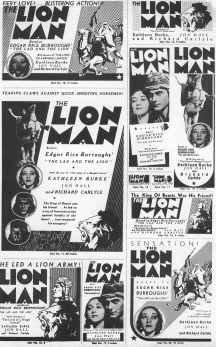
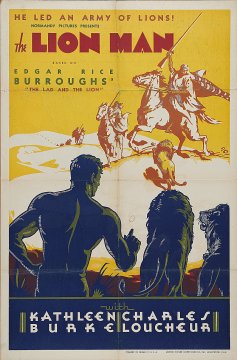
|
Lad and the Lion on the Front Page of Canada's National Newspaper Boy and beast on a boat? Oldest idea in the world Sarah Schmidt ~ National Post Saturday, November 09, 2002 ERBzine 0502: ERBzine Silver Screen Filmography ERBzine 0013: ERB On The Silver Screen Pt. 1 ERBzine 0013a: ERB On The Silver Screen Pt. 2 ERBzine 0219: Lost Words of ERB ERBzine 0220: Illustrated ERB Pulp Bibliography ERBzine 0239: Sacred Icons of J. Allen St. John ERBzine 0240: Numa's Lair with a Guide to our Other St. John Sites ERBzine 0447 Nkima's Chat #16 ~ Edgar and the Lions ERBzine 0448 Numa's Lair Pt. 2: A Photo Gallery ERBzine 0449: Nkima's Chat #17 ~ The Lad and the Lion Illustrated ERB Bibliography |
![]()
Go To Part II:
BACKGROUND: Volume
2380 and TEXT: Volume
2380a
THE CONTROVERSY
AROUND ERB'S FIRST FILM
Cave Girl ~ Isle of Content ~ Lad and the Lion
![]()
![]()
![]()
Volume
0450
![]()

![]()
BILL
HILLMAN
Visit
our thousands of other sites at:
BILL
AND SUE-ON HILLMAN ECLECTIC STUDIO
All
ERB Images© and Tarzan® are Copyright ERB, Inc.- All Rights Reserved.
All
Original Work © 1996-2006/2019 by Bill Hillman and/or Contributing
Authors/Owners
No
part of this web site may be reproduced without permission from the respective
owners.